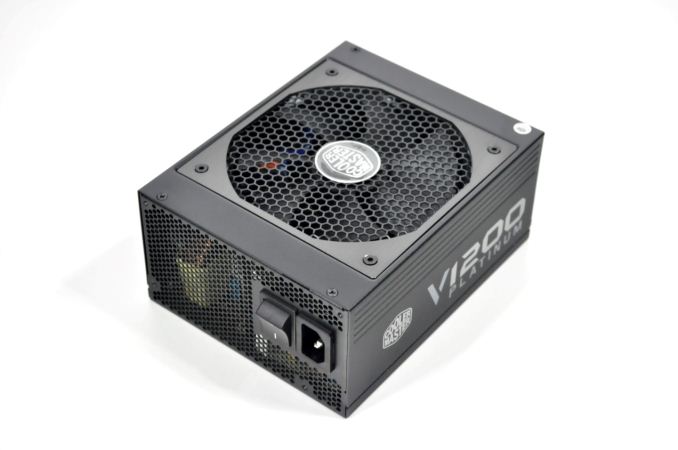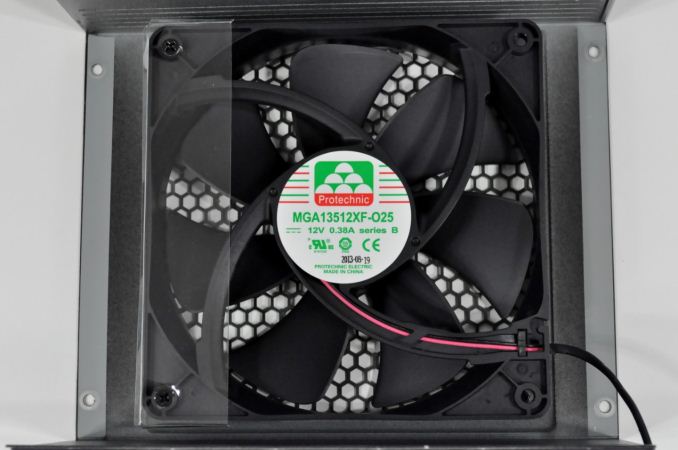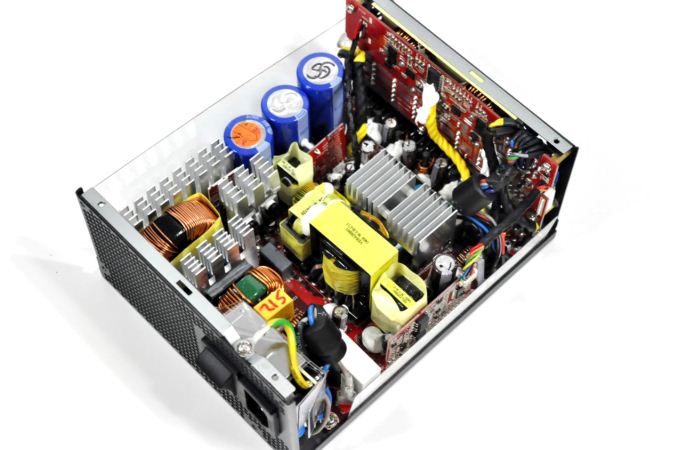Cooler Master V1200 Platinum Power Supply Review
by E. Fylladitakis on November 21, 2014 2:00 PM EST- Posted in
- Cases/Cooling/PSUs
- Seasonic
- 1200W
- Cooler Master
External Appearance
The Cooler Master V1200 Platinum sports an aesthetically pleasing yet not extravagant design. Experienced eyes will recognize the ODM of this unit by its external appearance alone, even though it is not exactly the same as the original design. Parallel line engravings and the model logo decorate the sides of the black chassis, applied so that they will appear properly from a windowed side panel, regardless if the unit has been installed with the fan facing upwards or downwards. The typical fan guard has been replaced with a grey plate forming a honeycomb mesh and with the company badge over the fan motor. Cooler Master placed the sticker with the electrical specifications of the unit at the top side of the chassis.
The rear side of the chassis is as usual relatively uninteresting, with a typical C14 receptacle next to an oversized switch. The front side however is littered with the numerous connectors for the modular cables. The PCI Express and CPU connectors are in line across the edge of the unit, but the connectors are keyed and there is no risk of inserting a cable into the wrong connector. There also is a small connector for the hybrid fan switch, which goes to the bracket that can occupy an expansion slot of the case.
Internal Design
Cooler Master installed a high speed 135mm fan from Protechnic Electric inside the V1200 Platinum. It is a high quality fan with a dual ball bearing engine and a maximum speed of 2300RPM. The company reports a maximum airflow of 115.8CFM, which is close to the airflow that our instrumentation displayed, as we measured it at 109.4CFM.
If the external design of the Cooler Master V1200 Platinum was not enough of a hint regarding the OEM behind it, the removal of its cover instantly reveals that this is a Seasonic XP3 platform, the same platform Seasonic used to create the Platinum SS-1200XP3. Cooler Master did not perform any notable changes on the design of the unit, with the exception of the Active PFC capacitors. There are two 330μF capacitors and one 390μF capacitor supplied by Hitachi in the V1200 Platinum, where Seasonic had three 390μF capacitors from Nippon Chemi-Con installed. All of the secondary capacitors however, electrolytic and solid-state alike, are still supplied by Nippon Chemi-Con.
The filtering stage begins on a shielded PCB attached to the back of the AC receptacle and continues on the main PCB. There are six Y capacitors, four X capacitors, and three filtering inductors inside the V1200 Platinum, forming a very strong AC filtering stage. It has two primary rectifying bridges attached on a sizable heatsink, right before the large APFC inductor.
The active components of the PFC stage, one diode and three FETs, are attached to the larger heatsink near the edge of the PCB. The smaller heatsink near the center of the unit cools the four transistors that form a full-bridge primary inversion stage. Two square heatsinks cool the active components of the secondary conversion stage, which are not directly attached to the heatsinks but are on the rear of the main PCB instead.
As the Cooler Master V1200 Platinum is manufactured by Seasonic, it shares the exceptional design and soldering quality as the SS-1200XP3 as well. Cooler Master also kept the very high quality passive and active components. However, the V1200 Platinum also shares the messy assembly job that we encountered in our review of the SS-1200XP3. It is not a bad assembly job, but it is not up to the standards that Seasonic has us used to. There are cables pressing against components and many electrolytic capacitors appear to have received mechanical force after they have been soldered on the board, tilting them left and right, while the glue appears to have been spilt carelessly and purposelessly, as there are spots where it does not even touch the components it is supposed to.

























27 Comments
View All Comments
Essence_of_War - Friday, November 21, 2014 - link
Good gracious, that is a LOUD fan!Luscious - Friday, November 21, 2014 - link
Your sound measurements are off.I have this power supply, and at 1200 watts it is quiet.
JarredWalton - Friday, November 21, 2014 - link
What SPL meter did you use, what are the test conditions, what is the precise output load (in watts), and how far from the PSU are you measuring noise? My guess is: you don't have an SPL meter, your PSU is in a closed up case, the load is probably more like 700-900W at most, and you're sitting a few feet away. Remember, input power is not output power, and generating a load of 1200W would require basically four R9 290X GPUs running at max power with a bit of overclocking added in for good measure. There aren't many ways regular PC users would ever have a constant load anywhere near 1200W, and at 800W (which is still a lot for a PC) the noise is quite a bit lower.bebimbap - Friday, November 21, 2014 - link
I love these power supply reviews, esp the value statements in the conclusion. That is exactly how I would think.I especially appreciate the hot tests. They are tests a reasonable consumer could not easily perform at home.
Luscious - Saturday, November 22, 2014 - link
I admire your attempt to uphold your article's credibility, but did you think for a minute that perhaps you received a flawed unit, or compare your results with those of other credible reviews already out prior to publishing your findings?Going into detail here regarding my setup would require a page and a half, however I will say that I was running four 780's pushing near 1200MHz and an overclocked 5960X at 1.25 volts. And that doesn't include the ~100 watts needed by the dozen Bitfenix PWM fans on the rads used to cool all of this. No, this was not in a closed case, the load being pulled from the wall was between 1150 and 1290 watts depending on the job being run, and I was not sitting "a few feet" away as you think I might have been.
In the three reviews listed here, neither mentions this power supply being as loud as your review suggests:
http://www.techpowerup.com/reviews/CoolerMaster/V1...
http://www.kitguru.net/components/power-supplies/z...
http://www.overclock3d.net/articles/power_supply/c...
Galidou - Sunday, November 23, 2014 - link
What kind of an answer is that man, giving links that doesn't even match the message you're sending to the anandtech reviewer?Overclock 3D isn't a full review all he says is that it's quiet, no ambient room temperature no noise mesurement device based on his opinion only. One page review where half of the time on the video speaks about the ripple suppression and the overhype of coolermaster about that.
Techpowerup comes to about the same results from 800 to 1200 watts power usage hovering around 51 to 54dba. Only results that differ a little are lower ambient temperature but again they use a custom anechoic chamber to measure noise that reduces the ambient noises to 20dba which is not normal usage, no one games in an anechoic room and some people are really used to outstanding ambient noise.
Kitguru is the only one with very lower numbers but then again they use THEIR acoustic room, doesn't specify what kind of fan settings they are using and so on.
Three reviews different on their testing methodology and you tell us you have a DOZEN bitfenix fans on the rad plus what other noise around you, no wonder why you think it's quiet, you live in the noise! what's your sound measurement tool? From what I can hear ''I was not sitting "a few feet" away'' your EARS?
Goodbye! Brush up on your reading skills man nice system you have btw.
E.Fyll - Tuesday, November 25, 2014 - link
I will simply comment that do not feel the need to "compare" my results prior to publishing them. And, trust me, I can tell if a unit is "flawed" or not.In the three reviews you mentioned, only one is actual, complete work and its results coincide with mine. Actually, since the floor noise of Techpowerup's setup is significantly lower, the PSU they tested appears to be even louder.
vred - Friday, November 21, 2014 - link
I have Seasonic SS-1200XP3, and its fan is quite loud when the PSU is fully loaded. I replaced it with Corsair AX1500i, and the fan noise is day and night compared to Seasonic - really quiet. My system easily draws 1100-1300 watts with 4 watercooled Titan Black videocards and really allows those PSUs to show what they are capable of.Flunk - Friday, November 21, 2014 - link
"This makes it virtually unsuitable for users with very advanced gaming systems that try to keep them as quiet as possible"Who would that be? Anything that needs a 1200watt power supply isn't going to be quiet. Quad SLI systems are loud, even with liquid cooling.
E.Fyll - Friday, November 21, 2014 - link
Well, it can be entirely quiet, but it will also be very, very expensive.The thing is, sound power and sound pressure are additive figures. This means that if you have a noise source that outputs a total SPL of 50dB(A) and add another device that outputs another 45dB(A) to it, you will have a system with a total SPL of 50+45 dB(A). That's NOT 95dB(A), the scale is logarithmic, so the exact math are X = 10log[(10^5.0)+(10^4.5)] = 51.193 dB(A).
To make things simpler, no, I do not expect that such a powerful system will ever be entirely quiet. You can however build a system that is fairly comfortable for everyday use and gaming without terrible effort. But if you keep adding high noise sources, the total noise output of the system increases and it will sooner or later surpass that "comfort threshold". Ignoring the noise output of a power supply just because the rest of the system "is not quiet anyway" is very logical - a noisy power supply will make the entire system, which already is not quiet, even louder.